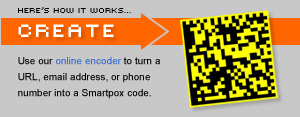Mytago and Smartpox
September 15th, 2006 by Hugh

“Use Mytago and convert your phone into a magic bookmarking and tagging tool. Use bookmarks from the offline world for online sharing and exploring. Connect your offline and online worlds.”
Mytago is a piece of software that you can load onto one of the new smartphones that are becoming “devices for life.” It makes use of the inbuilt camera to scan text, pictures and symbols. I find it hard to understand how the text part fits in (perhaps somebody can enlighten me), but the “tag” idea is straightforward enough:
“During the day, you see a Mytago tag on a poster of an event of your interest. You scan it by taking a snapshot with your mobile phone camera as a bookmark for the event. Later at home, you transfer the tag to your laptop and upload it to mytago.com and get all the details about the event.”
 Another similar idea comes from the oddly but memorably named Smartpox. (I suppose they are hoping that their name will go viral). The Smartpox code is a square barcode that you can print in the real world of posters and newspapers. Suppose you are a band promoting a single. Users point their mobile phone camera at your Smartpox and hear a sample of your music.
Another similar idea comes from the oddly but memorably named Smartpox. (I suppose they are hoping that their name will go viral). The Smartpox code is a square barcode that you can print in the real world of posters and newspapers. Suppose you are a band promoting a single. Users point their mobile phone camera at your Smartpox and hear a sample of your music.
Mashable makes an important point:
“The concept makes a lot of sense, although it isn’t exactly new. In fact, all these systems suffer from a serious chicken and egg problem: there’s no point in creating a code unless a decent number of people have the reader, and there’s no point in getting the reader unless there are plenty of codes around. So while Smartpox is a forward-looking idea, I don’t see it taking off in a big way.”
But despite the skepticsm, Japan provides an example that shows that this sort of thing can take off. QR Codes can now be accessed via camera phones. According to the Wikipedia, they are cropping up frequently in Japanese magazine advertisements and on business cards. You can even find them on the wrappers of Japanese McDonald’s burgers.
Exbiblio is clearly operating in the same space – but it’s ingeniously using text as the unique identifier. I see this as a huge advantage because you don’t have to create special barcodes, and any line of text is potentially a hyperlink. The weakness, in my view, is that you have to buy a scanner pen, and then remember to take it with you when you go out. This is quite a big egg for the chicken to lay. (I remind readers here that I’m an outside blogger, and I’ve been asked recently to give a few more of my own opinions). It seems to me that software that can be loaded onto camera phones is a fast expanding business model. I mentioned recently that you can use the video camera in the latest Nokia to analyse your golf swing. This is the sort of thing that is really taking off now.
Finally, my thanks to the skeptical Dead 2.0 where I read about these phone-scanners. I leave you with his thoughts on barcodes – and I think it’s fair to say that Exbiblio is addressing these issues:
“I’d rather see one of these company build a real-time scanner than can pick up the URL or email address off something printed than go through this rigmarole. Oh, one last thing, to ensure them the proper place in Web 2.0 land, they added in social networking features as well. Cuz there ain’t nothing more fun than having friends share UPC codes with each other.”


 The Economist is asking “
The Economist is asking “